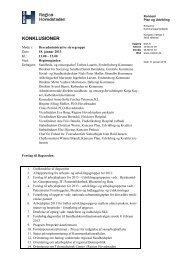Territorial Review Copenhagen - Region Hovedstaden
Territorial Review Copenhagen - Region Hovedstaden
Territorial Review Copenhagen - Region Hovedstaden
You also want an ePaper? Increase the reach of your titles
YUMPU automatically turns print PDFs into web optimized ePapers that Google loves.
250<br />
of universities is to produce creative workers that drive the knowledge<br />
economy.<br />
It is a robust finding in the economics literature that human skills have a<br />
positive impact on regional competitiveness. Glaeser et al. (1995), using a<br />
data set of 203 US cities between 1960 and 1990, found that a key variable<br />
for cities is the initial education level of the population: cities with higher<br />
median years of schooling show faster subsequent per capita income<br />
growth. A one standard deviation rise in median years of schooling raises<br />
income 2.78% over the same period. Higher education is found to influence<br />
growth through influencing the growth of technology. Berry and Glaeser<br />
(2005), using data on 318 metropolitan area in the United States over 1990-<br />
2000, have found that places with higher levels of human capital have<br />
attracted more skilled people over the last three decades. They show a strong<br />
correlation between the initial share of metropolitan area adults with college<br />
degrees and change in that variable over the 1990s. They suggest that this<br />
phenomenon might have been explained by the fact that labour demand is<br />
often created by local entrepreneurs who start firms in their own city. If<br />
skilled people are increasingly likely to start firms that hire other skilled<br />
people, this could explain why an initially high level of skills would lead to<br />
a growth in the skill composition of a city over time. Shapiro (2006) found<br />
that a 10% increase in a metropolitan area‘s concentration of collegeeducated<br />
residents was associated with a 0.8% increase in subsequent<br />
employment growth in the United States between 1940 and 1990. Roughly<br />
60% of the employment growth effect of college graduates is found to be<br />
explained by enhanced productivity growth. Moretti (2004) finds that<br />
productivity of plants in cities that experience large increases in the share of<br />
college graduates rises more than the productivity of similar plants in cities<br />
that experience small increases in the share of college graduates. According<br />
to his most robust estimates, a 1% increase in the city share of college<br />
graduates is associated with a 0.5-0.6 percentage-point increase in output.<br />
Because the stock of human capital grows slowly over time, the contribution<br />
of human capital spillovers to economic growth is not large. The most<br />
robust estimates in the Moretti paper indicate that human capital spillovers<br />
are responsible for an average of 0.1 percent increase in output per year<br />
during the 1980s. Simmie et al. (2002) analysed innovation in five European<br />
cities and suggested that the top reason why firms would choose to locate<br />
the development of new innovation in a particular city region was the<br />
availability of professional experts specialising in the relevant technology.<br />
Large cities have the advantage that they will be able to have a larger<br />
supply of jobs for highly qualified couples. Costa and Kahn (2000) found<br />
that college-educated couples have over 1940-1990 become increasingly<br />
located in large metropolitan areas in the United States. They find that the

















